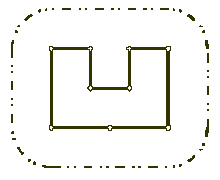Wall
| Time Limit: 1000MS | Memory Limit: 10000K | |
| Total Submissions: 35684 | Accepted: 12177 |
Description
Once upon a time there was a greedy King who ordered his chief Architect to build a wall around the King's castle. The King was so greedy, that he would not listen to his Architect's proposals to build a beautiful brick wall with a perfect shape and nice tall towers. Instead, he ordered to build the wall around the whole castle using the least amount of stone and labor, but demanded that the wall should not come closer to the castle than a certain distance. If the King finds that the Architect has used more resources to build the wall than it was absolutely necessary to satisfy those requirements, then the Architect will loose his head. Moreover, he demanded Architect to introduce at once a plan of the wall listing the exact amount of resources that are needed to build the wall.

Your task is to help poor Architect to save his head, by writing a program that will find the minimum possible length of the wall that he could build around the castle to satisfy King's requirements.
The task is somewhat simplified by the fact, that the King's castle has a polygonal shape and is situated on a flat ground. The Architect has already established a Cartesian coordinate system and has precisely measured the coordinates of all castle's vertices in feet.

Your task is to help poor Architect to save his head, by writing a program that will find the minimum possible length of the wall that he could build around the castle to satisfy King's requirements.
The task is somewhat simplified by the fact, that the King's castle has a polygonal shape and is situated on a flat ground. The Architect has already established a Cartesian coordinate system and has precisely measured the coordinates of all castle's vertices in feet.
Input
The first line of the input file contains two integer numbers N and L separated by a space. N (3 <= N <= 1000) is the number of vertices in the King's castle, and L (1 <= L <= 1000) is the minimal number of feet that King allows for the wall to come close to the castle.
Next N lines describe coordinates of castle's vertices in a clockwise order. Each line contains two integer numbers Xi and Yi separated by a space (-10000 <= Xi, Yi <= 10000) that represent the coordinates of ith vertex. All vertices are different and the sides of the castle do not intersect anywhere except for vertices.
Next N lines describe coordinates of castle's vertices in a clockwise order. Each line contains two integer numbers Xi and Yi separated by a space (-10000 <= Xi, Yi <= 10000) that represent the coordinates of ith vertex. All vertices are different and the sides of the castle do not intersect anywhere except for vertices.
Output
Write to the output file the single number that represents the minimal possible length of the wall in feet that could be built around the castle to satisfy King's requirements. You must present the integer number of feet to the King, because the floating numbers are not invented yet. However, you must round the result in such a way, that it is accurate to 8 inches (1 foot is equal to 12 inches), since the King will not tolerate larger error in the estimates.
Sample Input
9 100 200 400 300 400 300 300 400 300 400 400 500 400 500 200 350 200 200 200
Sample Output
1628
题意:
给定多边形城堡的n个顶点,绕城堡外面建一个围墙,围住所有点,并且墙与所有点的距离至少为L,求这个墙最小的长度。
解题思路:
城堡围墙长度最小值 = 城堡顶点坐标构成的散点集的凸包总边长 + 半径为L的圆周长
#include <cstdio>
#include <string>
#include <iostream>
#include <cstring>
#include <cctype>
#include <algorithm>
#include <functional>
#include <cstdlib>
#include <list>
#include <utility>
#include <vector>
#include <bitset>
#include <cmath>
using namespace std;
typedef long long LL;
const int maxn = 1e3 + 5;
const double EPS = 1e-6;
const double PI = acos(-1.0);
//考虑误差的加法运算
double Add(double a, double b) {
if (abs(a + b) < EPS * (abs(a) + abs(b))) return 0;
return a + b;
}
//二维向量结构体
struct Point2 {
double x, y;
Point2() {}
Point2(double x, double y) : x(x), y(y) {}
Point2 operator+(const Point2& p) const {
return Point2(Add(x, p.x), Add(y, p.y));
}
Point2 operator-(const Point2& p) const {
return Point2(Add(x, -p.x), Add(y, -p.y));
}
Point2 operator*(double d) {
return Point2(x*d, y*d);
}
//內积
double Dot(const Point2& p) const {
return Add(x*p.x, y*p.y);
}
//外积
double Det(const Point2& p) const {
return Add(x*p.y, -y*p.x);
}
};
bool CmpXY(const Point2& p, const Point2& q) {
if (p.x != q.x) return p.x < q.x;
return p.y < q.y;
}
//求凸包
vector<Point2> GrahamScan(Point2* ps, int n) {
sort(ps, ps + n, CmpXY);
int k = 0; //凸包的顶点数
vector<Point2> qs(n << 1);
//构造凸包的下侧
for (int i = 0; i < n; ++i) {
while (k > 1 && (qs[k - 1] - qs[k - 2]).Det(ps[i] - qs[k - 1]) <= 0) --k;
qs[k++] = ps[i];
}
//构造凸包上侧
for (int i = n - 2, t = k; i >= 0; --i) {
while (k > t && (qs[k - 1] - qs[k - 2]).Det(ps[i] - qs[k - 1]) <= 0) --k;
qs[k++] = ps[i];
}
qs.resize(k - 1);
return qs;
}
//两点间距离
double Dist(const Point2& p, const Point2& q) {
return sqrt((p - q).Dot(p - q));
}
double Solve(Point2* p, int n, int r) {
vector<Point2> convexHull = GrahamScan(p, n);
double len = Dist(*convexHull.begin(), *(convexHull.end() - 1));
for (int i = 1; i < convexHull.size(); ++i) {
len += Dist(convexHull[i], convexHull[i - 1]);
}
len += PI * 2 * r;
return len;
}
int main() {
#ifdef NIGHT_13
freopen("in.txt", "r", stdin);
#endif
std::ios::sync_with_stdio(false);
int n, r;
Point2 p[maxn];
while (scanf("%d%d", &n, &r) == 2) {
for (int i = 0; i < n; ++i) {
scanf("%lf%lf", &p[i].x, &p[i].y);
}
printf("%.0f\n", Solve(p, n, r));
}
return 0;
}




















 1600
1600











 被折叠的 条评论
为什么被折叠?
被折叠的 条评论
为什么被折叠?








